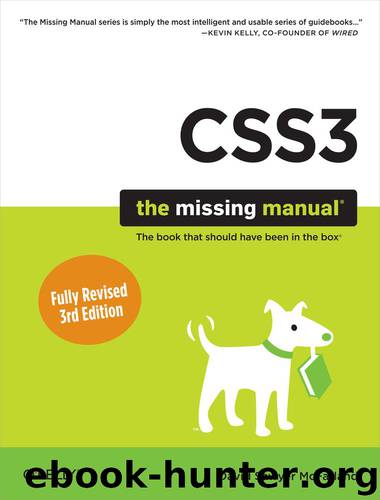CSS3: The Missing Manual by David Sawyer McFarland

Author:David Sawyer McFarland [David Sawyer McFarland]
Language: eng
Format: epub, mobi
Tags: COMPUTERS / Web / Page Design
ISBN: 9781449339470
Publisher: O'Reilly Media
Published: 2012-12-17T16:00:00+00:00
Note
You don’t need the -ms- vendor prefix for Internet Explorer in this case. IE 9 and earlier don’t understand CSS animations anyway, and IE 10 supports the @keyframes syntax without a prefix.
Applying an Animation
Once you’ve completed a set of keyframes, the animation is ready. However, to make it work, you need to apply it to an element on your page. You can add an animation to any style for any element on a page. If you simply add the animation to a style that applies immediately to an element—for example, an h1 tag style—the animation will apply when the page loads. You can use this technique to add an introductory animation to a page that makes a logo zoom into place in the page’s upper-left, or make a particular box of content glow to draw attention to it.
In addition, you can apply an animation to one of the pseudo-classes, including :hover, :active, :target, or :focus to make an animation run when a visitor mouses over a link, for example, or clicks into a form field. Finally, you can apply the animation to a class style and use JavaScript to dynamically apply that class in response to a visitor clicking a button or some other page element (see the box on Using JavaScript to Trigger Transitions).
CSS3 provides a handful of animation-related properties to control how and when an animation plays back (as well as a shorthand version that encompasses all the individual properties). At a minimum, to get an animation running, you need to supply the name you gave the original animation (in the @keyframes rule as discussed on Defining Keyframes), and a duration for the animation.
Here’s a simple example. Say you want a div with an important announcement to fade into view when the page loads. You’ve given that div a class name of announcement: -<div class=“announcement”>.
Create the fade-in animation with the @keyframes rule:
@keyframes fadeIn { from { opacity: 0; } to { opacity: 1; } }
Download
CSS3: The Missing Manual by David Sawyer McFarland.mobi
This site does not store any files on its server. We only index and link to content provided by other sites. Please contact the content providers to delete copyright contents if any and email us, we'll remove relevant links or contents immediately.
| Content Management | Programming |
| User Experience & Usability | User Generated Content |
| Web Design | Web Marketing |
| Web Services | Website Analytics |
The Mikado Method by Ola Ellnestam Daniel Brolund(20604)
Hello! Python by Anthony Briggs(19900)
Secrets of the JavaScript Ninja by John Resig Bear Bibeault(18208)
Dependency Injection in .NET by Mark Seemann(18109)
The Well-Grounded Java Developer by Benjamin J. Evans Martijn Verburg(17576)
Kotlin in Action by Dmitry Jemerov(17185)
Sass and Compass in Action by Wynn Netherland Nathan Weizenbaum Chris Eppstein Brandon Mathis(13266)
Secrets of the JavaScript Ninja by John Resig & Bear Bibeault(11383)
Jquery UI in Action : Master the concepts Of Jquery UI: A Step By Step Approach by ANMOL GOYAL(9389)
Svelte with Test-Driven Development by Daniel Irvine(8140)
Test-Driven Development with PHP 8 by Rainier Sarabia(7889)
Layered Design for Ruby on Rails Applications by Dementyev Vladimir;(7707)
Web Development with Django by Ben Shaw Saurabh Badhwar(7216)
React Application Architecture for Production by Alan Alickovic(6900)
Software Architecture for Web Developers by Mihaela Roxana Ghidersa(4982)
Audition by Ryu Murakami(4891)
Accelerating Server-Side Development with Fastify by Manuel Spigolon Maksim Sinik & Matteo Collina(4838)
Solidity Programming Essentials by Ritesh Modi(4568)
Build Your Own Web Framework in Elixir by Aditya Iyengar(4439)
